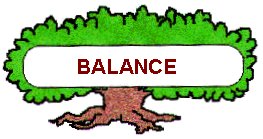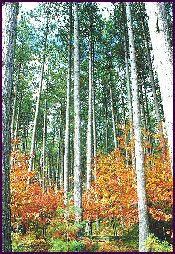

Home Page |
MICHIGAN FORESTS FOREVER TEACHERS GUIDE
| TREE PLANTATIONS |  |
For more about |
Plantations for timber production go back to the CCC days of the 1930s. At that time, society was concerned about the future supply of the domestic timber resource and unemployment levels were high. Not much was known about proper relationships between tree species and site suitability, but the sense of urgency was strong and millions of trees were planted. Many of these older plantations have now been thinned several times. Some have been harvested and replanted, or converted to other uses, such as housing or a parking lot.
 Today, the timber need for
plantations remains strong, especially softwood plantations,
particularly pines. About 30 million trees are planted in Michigan each year.
The most commonly planted species are red pine, jack pine, and white spruce. Plantations require intensive forestry and are efficient ways to produce wood fiber. They can be likened to agriculture, except the planting occurs only once every
60-100+ years and harvesting from thinnings may occur every 10 years or so.
Plantations, of course, are also much "lighter on the land" than farming because
they are more like a forest system than a corn field. However, some people are
concerned about the lower levels of species diversity and other ecological issues that
are sometimes associated with plantations.
Today, the timber need for
plantations remains strong, especially softwood plantations,
particularly pines. About 30 million trees are planted in Michigan each year.
The most commonly planted species are red pine, jack pine, and white spruce. Plantations require intensive forestry and are efficient ways to produce wood fiber. They can be likened to agriculture, except the planting occurs only once every
60-100+ years and harvesting from thinnings may occur every 10 years or so.
Plantations, of course, are also much "lighter on the land" than farming because
they are more like a forest system than a corn field. However, some people are
concerned about the lower levels of species diversity and other ecological issues that
are sometimes associated with plantations.
Planting trees is often one of the first activities associated with "forestry". A simple concept, but it's actually quite easy to kill seedlings or set the stage for future growth problems. Exposing the roots to warm, dry air for even a few minutes can kill the fine root hairs, dooming the seedling. For information about planting techniques, click here. And in the Lake States, for the most part, we don't need to plant trees in order to regeneration the forest. Our management systems successfully secure natural regeneration.
Plantation establishment involves MUCH more than just planting trees. In most cases, the site needs to be properly prepared, which involves the removal of competing vegetation. This is usually done with herbicides, which can sometimes be controversial (more perception than science, however). After the amount of competing vegetation is reduced, then trees are planted in mineral soil. Additional treatment may be necessary to expose mineral soil, either by digging furrows or "scalping" small patches at regular intervals. Sometimes, prescribed burning is effective. After the seedlings are in the ground, the job isn't over. In most cases, an additional herbicide treatment or two is needed to control competing vegetation until the trees become tall enough to compete on their own. Most people seem to know that planted trees need full sunlight, but fewer people understand that underground competition for water and nutrients is also very important. That's one of the reasons why converting old fields to plantations is difficult. The root systems of grasses present serious challenges to seedling survival!
Where can your school obtain tree seedlings?
There are a number of sources. The best source for current information would be one the places listed below. Occasionally, grants fund tree planting projects at schools, on school forests, or in other places.
1. County Conservation District
2. DNR Office (private forest management specialist)
3. Commercial seedling nurseries
4. Natural Resource Conservation Service
 |
This website was developed and created by Michigan State University Extension for the teachers of the State of Michigan. |